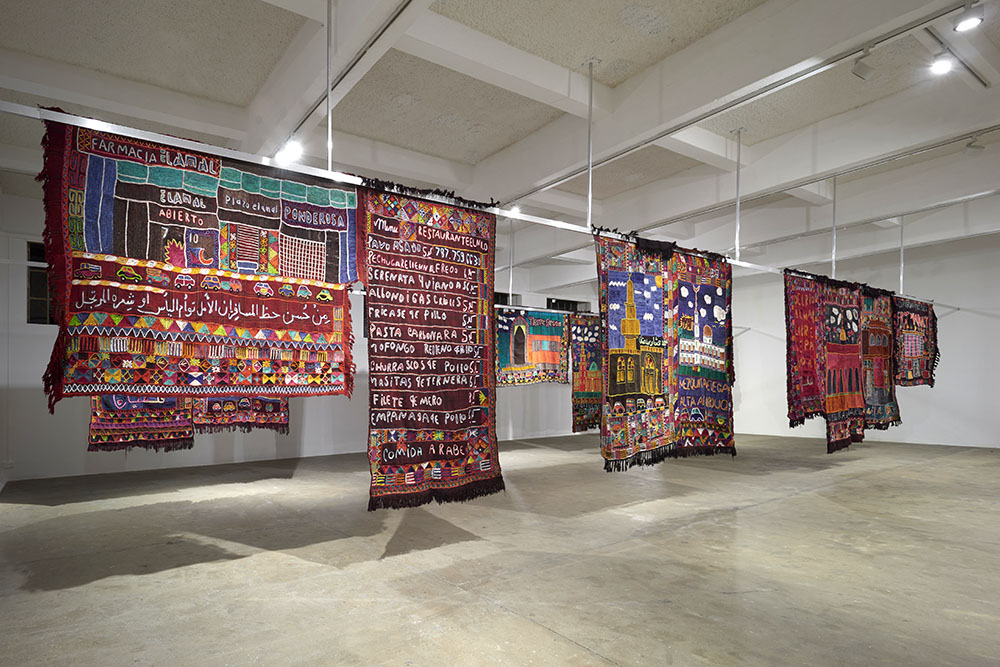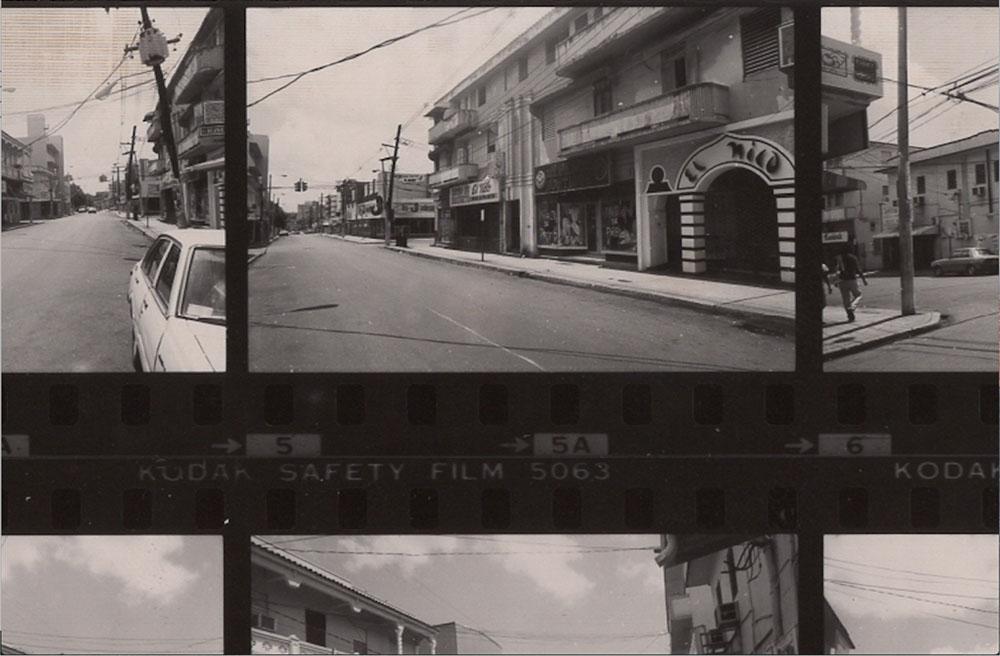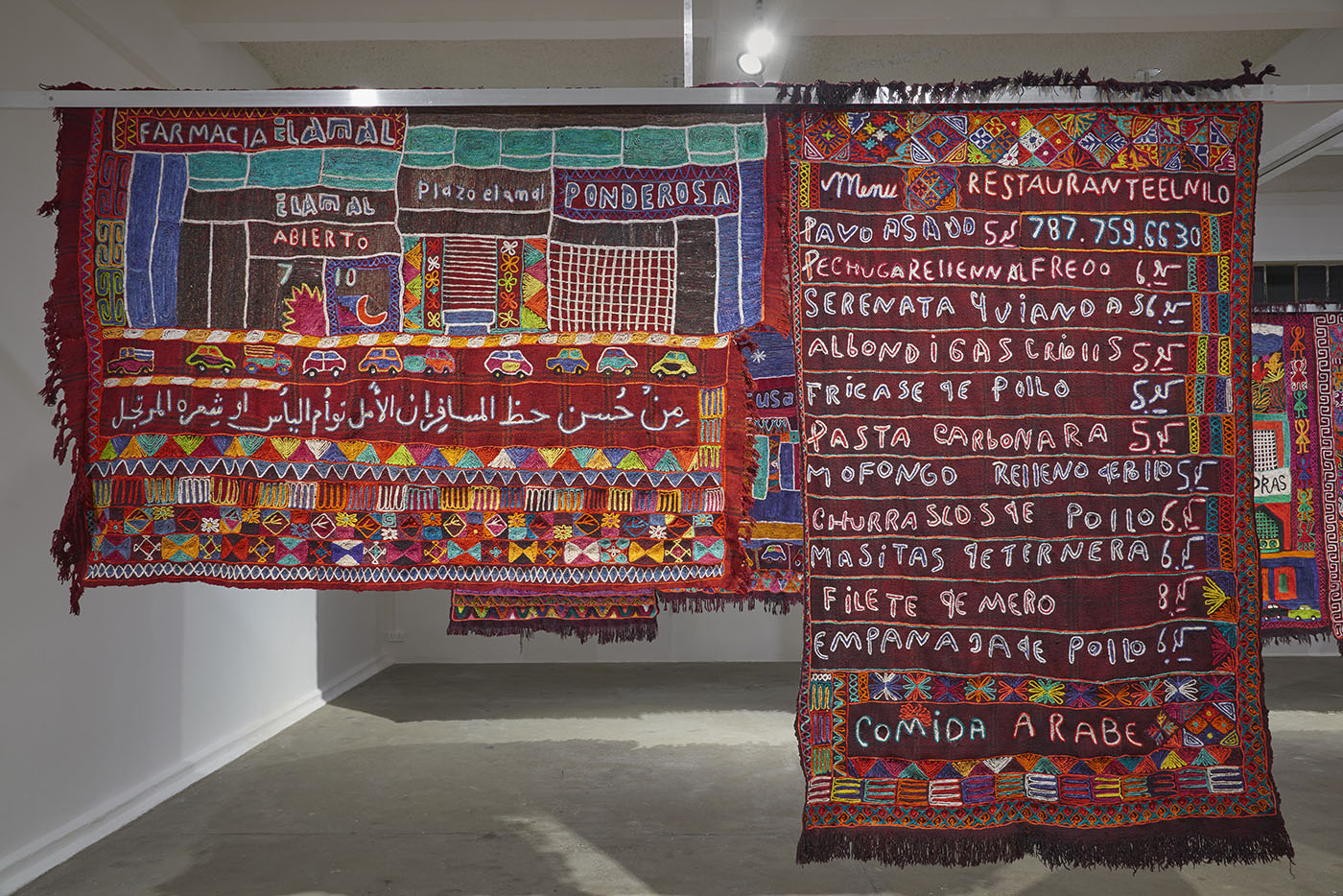In Alia Farid’s artworks, communities, local practices and traditions are reconsidered, giving the rhythms of everyday life political significance and potency. It is the first chapter of an ongoing research project, initially conceived in 2013, which maps Arab and South Asian migration to Latin America and the Caribbean. Her show Elsewhere is on view at the Chisenhale Gallery in London until February 4, 2024.
Sophie Kazan Makhlouf
In her 2011 book, See It Again, Say It Again, critic and art historian Janneke Wesseling considers how an artist’s creative practice can be that of a researcher, exploring ideas by drawing together material archives or materials and unwinding the viewer’s understanding of a concept in and through art. Wesseling describes this type of research and thinking about art as the same or equal to the practical action of making art. For her, the artist, whether he or she had a hand in creating the objects on show, becomes a generator of knowledge and their role is not only visual but also mindful.
Being able to relate to an artist as a researcher and understanding Wesseling’s points helped me to engage with Alia Farid’s first major solo exhibition in the UK, Elsewhere, at the Chisenhale Gallery in London. Elsewhere was commissioned as part of a project to map histories of Arab and South Asian diaspora communities, in Latin America and the Caribbean, and it relates to Farid’s material archive, her films and photography.

Founded by artists, the gallery’s focus is on the commissioning and production of new works of thought-provoking art by international artists.
Artists such as Farid, Ravelle Pillay, Lotus Laurie Kang and Benoît Piéron have been part of a wider program to explore the body through space and time. The gallery’s open plan and its situation in a multicultural area of East London is remarkably attuned to this exhibition, which is centered around 16 hand-woven and embroidered rugs. The rugs are hung on rails in three rows across the full length of the gallery.
The seeds for this project grew out of Farid’s meeting with Um Mohammed, the leader of a southern Iraqi weaving workshop, Samawah, while she was working on a short film, Chibayish in 2022. The film, which was shown at the Tate Modern last year, is set in the marshland around the Tigris and the Euphrates rivers. Through her film, the region’s cultural heritage, and its modern identity, are explored and confronted with the political and economic implications on the natural environment.
Farid became interested in the region’s material culture and in local food as well as the pots, traditional crafts and kilim carpets or flat weaves used daily by local people. She became entranced by the carpets which are an important part of local material custom. They become threadbare easily and so are strengthened and embellished simply, using colorful chain stitching. As well as becoming interested in the fibers traditionally used to color cloth, Farid was also inspired by the potential to portray landscapes in the carpets. “We don’t really have a tradition of landscape painting in the Arab world — landscapes are encountered through tapestries and architectural motifs instead,” she says. “I’m also interested in the materiality of a carpet or tapestry and how much information in relation to the landscape, it has the potential to contain.”
Through her work with the weavers, Farid is also drawing a line between local traditions and global migrations, which she refers to as a mental cartography, rooted to particular sites. In this way, her drawing together and sharing of the weaving traditional techniques and stories of this particular community frames the work and holds it up to history. In Elsewhere, the rugs portray the culture of the Palestinian diaspora in Puerto Rico, using Farid’s archive but also memories and experiences drawn from individual places, as they are now and as they used to be. The Elsewhere project forms part of the social and archival research gathered by the artist, who lives between Kuwait and Puerto Rico. Farid is a multidisciplinary artist and her work draws extremely broadly on similarities and reflections of places and peoples, highlighting particularly the architecture and diasporic culture that is reflected across the world.

According to Farid, the exhibition grew out of a conversation with fellow Puerto Rican artist Jesús Negrón, whose Cigarette Butt Street Rug, 2007 was exhibited in the Sharjah Biennale of the same year, and depicts a carpet made up of used cigarette butts found in the street. Having both returned from trips abroad, the artists were struck by the way that previously familiar buildings and peoples in Puerto Rico now seemed like replicas, transplanted from abroad. Now that their origins had been seen, the Latino version seemed at odds or awkward within their communities and the wider Latin cultural context. The artists reflected for example on the mosques and other structures of Ponce, Fajardo, Hatillo, Vega, Alta and Rio Piedras, which are depicted in the rugs.
The artist refers to the history and layering of migration stories here, one generation of shop owners or restaurateurs or pioneers leaving way for the next, creating a historical/cultural timeline. The images are not only beautifully crafted by the Iraqi weavers in a traditional method of flat weaving and chain stitching, the bright colors and playful Latin rhythms in the works also evoke the way that Palestinian and Arab migrations have created their own history and traditions within the region. The sayings and shops, the menus and mosques that have sprung up within daily life, weaving themselves into the life of the towns’ inhabitants and adding layers of richness to their socio-cultural make-up.
Since the curator of the exhibition is not listed as a single person, but rather as the gallery itself, with accompanying events and discussions happening around the exhibition, perhaps the exhibition talks or interviews would have increased my understanding of how and why this commission and the exhibition came about. Screen prints at the entrance depict images selected by the artist from the Puerto Rican weekly newspaper Claridad (Clarity, in English), and though I struggle to understand where these images fit into the artist’s practice, I recognize these as images of Arabic food from or inside Palestinian restaurants in the region. The exhibition’s title, Elsewhere, in my eyes is the artist’s study, or in many ways a love story, of growing up in a place that is not and can never really be entirely “yours.” That is the reality of many migrants, who were forced to leave their country and see their assimilation into another culture as a betrayal of their history and traditions. In this situation, food and prayers become central cultural practices and they take on ritualistic importance. That is why Farid portrays the restaurant, the shop and the mosque in these charming and whimsical rugs that hang like curtains across the gallery space.
Journeying along, around and through them, the viewer is confronted with the diasporic reality of being from a rich culture that is elsewhere.




